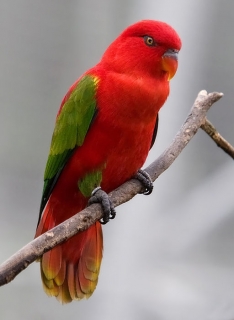Chattering Lory |
|
|
Also known as: Scarlet Lory, Yellow-backed Lory (L.g. flavopalliatus)
Photos
View in GalleryDid You Know?
Up to 70% of a lory or lorikeet's day is spent foraging for food. They will fly up to 30 miles in a day to find a food source.Programs & Projects
WPT has worked with numerous partners to help save this species. Learn moreAcademic Research
Related publications: Lorius garrulusSpecies Profile
Genus: Lorius | Species: garrulus
Size:
30cm (11.7 in)
Weight:
180-250g (6.3-8.75 oz)
Subspecies including nominate:
three: L.g. garrulus, L.g. flavopalliatus, L.g. morotaianus
Colour Adult:
L.g. garrulus: Both adults in general red, with scapulars having darker tint; yellow patch on mantle absent; green thighs and wings; yellow bend of wing and underwing coverts; pink/rose underwing stripe; red tail with black/green tip. Bill orange. Eye ring grey, eye orange/red.
L.g. flavopalliatus: Both adults as in garrulus but with yellow patch on mantle; brighter green on wings.
L.g. morotaianus: Both adults as in flavopalliatus but with yellow patch on mantle washed with green, duller and less extensive; darker green wings.
Colour Juvenile:
L.g. garrulus: As in adults but with brownish bill, paler grey/white eye ring and brown eye.
L.g. flavopalliatus: As in adults.
L.g. morotaianus: As in adults.
Call:
Calls are described as loud, nasal and quavery. Also makes braying sounds. Territorial calls while perched are raucous, two-syllable horn-like notes emitted singly or repeated two or three times.
Listen NowVideo Links:
Video 1 | Video 2More Information:
Content Sources:
CITES
BirdLife International
Cornell Lab of Ornithology/Birds of the World
Parrots: A Guide to Parrots of the World, Juniper and Parr, 1998
Parrots: Status Survey and Conservation Action Plan 2000-2004, Snyder, McGowan, Gilardi and Grajal, 2000.
Parrots of the World, Forshaw and Cooper, 1977. 2010 edition
Parrots of the World, Forshaw, 2006.
Lexicon of Parrots, Thomas Arndt.
Parrots in Aviculture, Low, 1992.
Photos
View in GalleryDid You Know?
Up to 70% of a lory or lorikeet's day is spent foraging for food. They will fly up to 30 miles in a day to find a food source.Programs & Projects
WPT has worked with numerous partners to help save this species. Learn moreAcademic Research
Related publications: Lorius garrulusSpecies Care
Captive Status:
Formerly common, now less so.
Longevity:
28-32 yrs
Housing:
Enclosure with drain in floor (sloping concrete with drain), or suspended cage over concrete floor.
Diet:
Commercial or homemade nectar (baby cereal, lactose-free; honey and malt extract or molasses, mixed with filtered water, made fresh once or twice daily); fruit once or twice daily: apple, pear, orange, banana, cactus fruits; one or more vegetable items daily: carrot, fresh corn, tinned sweet corn (unsalted), green leaves such as Swiss chard, lettuce or dandelion; rearing food made from hard-boiled egg, wholegrain bread and carrot, all ground to crumbly consistency.
Enrichment:
Provide daily baths, necessary because of nectar diet. Provide lots of bird-safe (non-toxic and unsprayed) flowering branches for perching and chewing.
Nest Box Size:
Diagonal box 16" x 8" x 12" (40.6cm x 20.3cm x 30.5cm).
Clutch Size:
2
Incubation Time:
26 days
Fledging Age:
10-11 weeks
Hatch Weight:
Not recorded.
Peak Weight:
Not recorded.
Weaning Weight:
Not recorded.
Specialist Club:
Photos
View in GalleryDid You Know?
Up to 70% of a lory or lorikeet's day is spent foraging for food. They will fly up to 30 miles in a day to find a food source.Programs & Projects
WPT has worked with numerous partners to help save this species. Learn moreAcademic Research
Related publications: Lorius garrulusSpecies Wild Status
World Population:
Unknown, decreasing.
IUCN Red List Status:
Vulnerable
CITES Listing:
Appendix II
Threat Summary:
A BirdLife “restricted-range” species. The main threat is trapping for the wild bird trade; several thousand are taken annually. Tree harvesting in the area has become more intensive in the twenty-first century, with mainly large nesting trees being taken.
Range:
L.g. garrulus: Halmahera and Widi Islands, N Moluccas.
L.g. flavopalliatus: Bacan and Obi, N Moluccas.
L.g. morotaianus: Morotai and Rau, N Moluccas.
Habitat:
Found in upland forested areas up to 1300m (4264 ft). Most commonly reported in primary and mature secondary forests away from settlements.
Wild Diet:
Feeds on pollen, fruits, nectar and flowers including coconut.
Ecology and Behaviour:
Reported in pairs. Noisy and conspicuous in flight but are difficult to spot while feeding in forest canopy.
Clutch and Egg Size:
2 elliptical eggs, 26.0 x 22.0mm (1 x 0.8 in)
Breeding Season:
June, with young fledged by October-November. Nest is in woody swelling in tall tree.
Related Links:
Wikipedia
Research: An assessment of parrot trade on Obi Island reveals heavy exploitation of the Chattering Lory
Photos
View in GalleryDid You Know?
Up to 70% of a lory or lorikeet's day is spent foraging for food. They will fly up to 30 miles in a day to find a food source.Programs & Projects
WPT has worked with numerous partners to help save this species. Learn moreAcademic Research
Related publications: Lorius garrulusMembers Only Resources
Please log-in now to find more research, resources and tools.
Not a Member?
Find more great information:
Gain exclusive access to 600+ pages of additional research, seminars and podcasts, specialists to ask your toughest questions, and dozens of other fun resources - when you become a WPT member.
Join Today >>

































